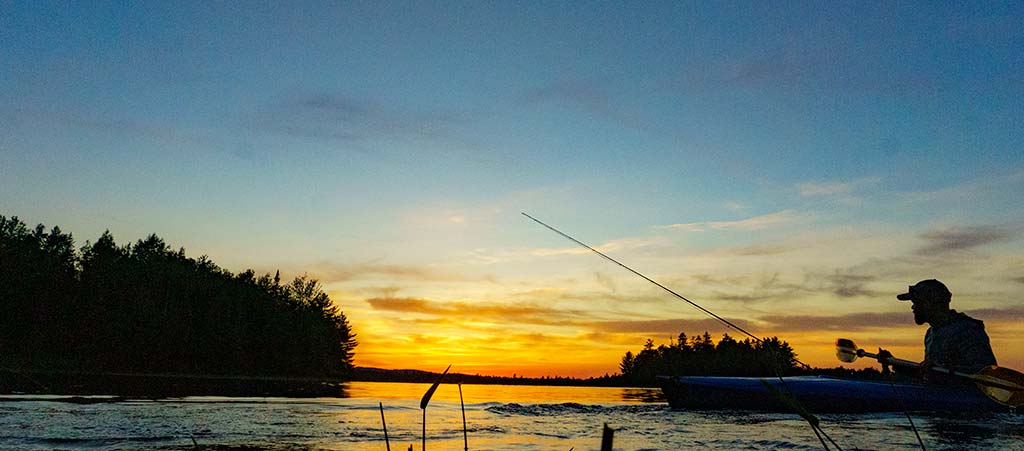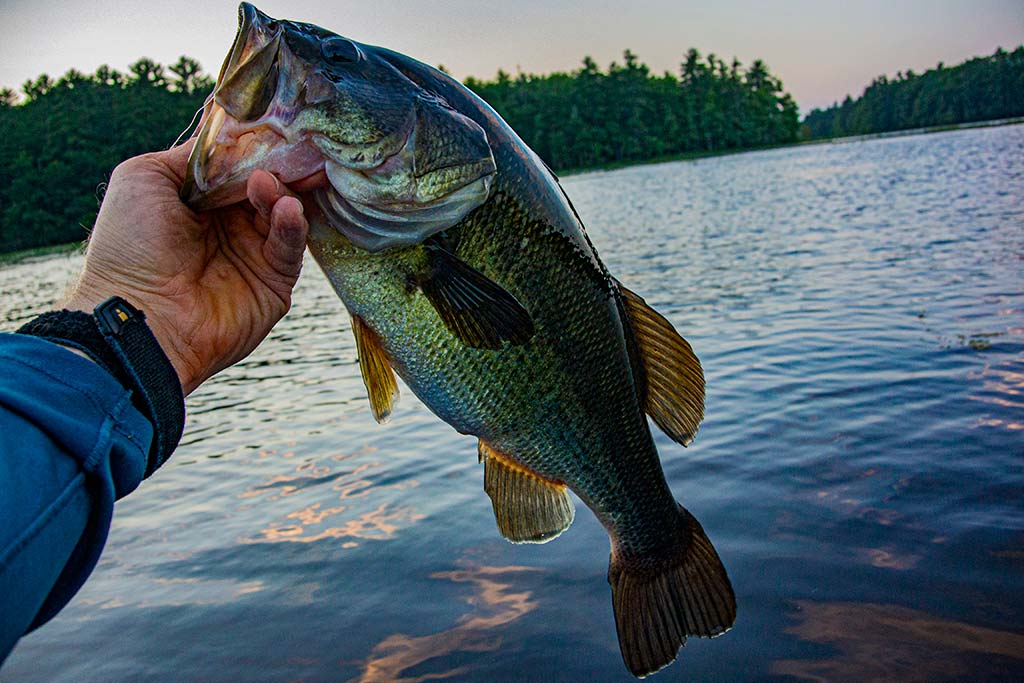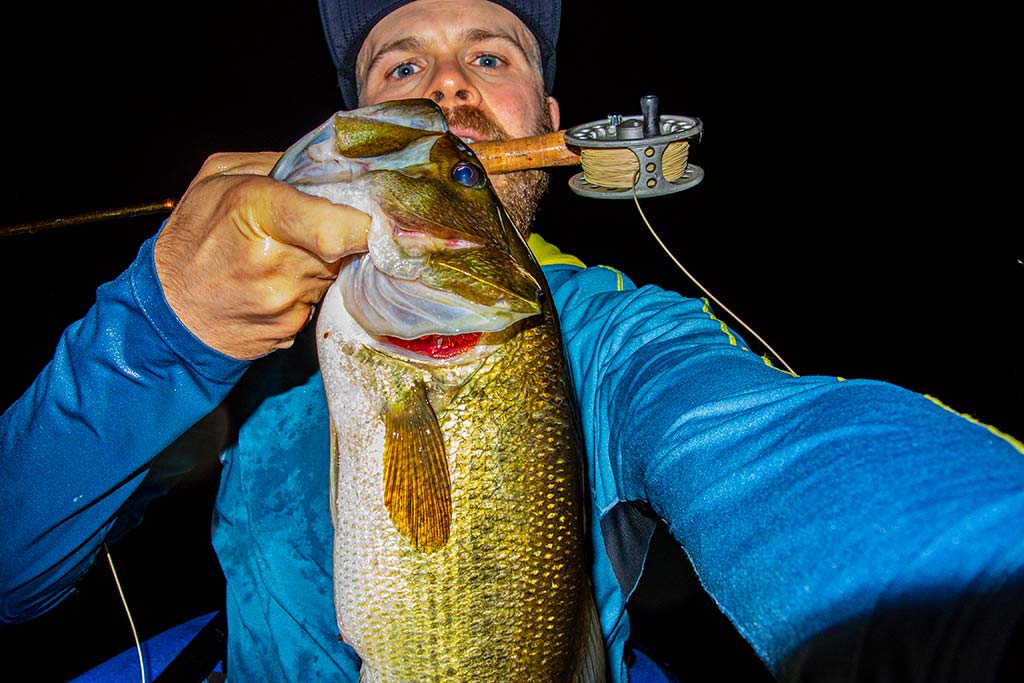
Combining the stealthy benefits of the kayak and fly rod just might be the perfect way to target summertime largemouth bass.
The kayak is the perfect vessel with which to hunt largemouth bass on the fly. One of the huge advantages of a kayak is the ability to get into very skinny water with very little disturbance to the environment, above or below the surface; and the exact same thing can be said for fly fishing. As pressure increases on lakes and ponds in the summer and through the fall, the kayak and fly rod make a deadly stealth-combination. I’m not sure why fly fishing for largemouth isn’t more popular, but I believe it’s the most exciting way to target these beloved fish.
My father and I were early adopters of kayak fishing long before they began making fishing-specific kayaks. We enjoy the simplicity of using our kayaks, how easily we blend in with the wildlife (kayaks being so quiet), and the intimacy of being right down on the surface of the water with the fish; there is a “close combat” feeling to fishing out of a kayak. I still think kayak fishing perfectly straddles the line between shore fishing and boat fishing, and bass fishing with the fly rod in my kayak remains my preferred non-wading option. Having a big bass take a fly, then explode from the surface, jumping higher than your head, is something I think every fisherman should experience!
You don’t need a fancy gear to get started with bass-kayak-fly fishing either. While I prefer a sit-on-top or open cockpit kayak design for fly fishing, you can make whatever you have work. However, having a sit-on-top allows you to keep the line loosely organized in front of you. If you have a sit-in kayak, it can be awkward to strip the line into your lap, and I find it makes me hold the rod up uncomfortably and unnaturally. Therefore, I end up stripping the line into the water at the side of the kayak. This increases the effort required to cast, and also increases the likelihood that your line will end up tangled in surface-level weeds; best to keep the line in the boat. To this point, no matter what kind of kayak you have, if you want to start fly fishing out of it, consider removing any unnecessary rod holders, camera mounts, depth finders, leashes, or mounting points that the line could catch, because it WILL get tangled on it. I find less is more when I’m fly fishing out of the kayak I prefer as little “stuff” in front of me as possible.
I suggest getting very, very comfortable with your kayak before you actually start fly fishing out of it, even if you have already been spin fishing. How stable is it? Where is the tipping point? What will you do if you tip over? These are all things you should know and practice ahead of time because there is a lot more back-and-forth motion required in a fly cast. I find that, versus a spinning rod, it requires a more nuanced understanding of your kayak’s dynamics to feel comfortable and also maximize casting distance. Further, asking yourself “how will I hold the paddle while I fly cast?” is a good idea as well. I hate having it across my lap as it’s something else to get tangled on, and the motion of casting tends to roll it out of my lap annoyingly. Therefore, having the capacity to either bungee it to the kayak (on the opposite side I generally cast to), or the ability to stow it in front of me, is important.

One of the best tips for making the most of the fly rod in a kayak is to practicing some casting from a sitting or kneeling position before you head out onto the water. Getting used to the diminished height and lack of lower body involvement you will face while in the kayak is crucial. Sitting requires different mechanics to cast effectively, and I find I’m very reliant on the hauling technique. The ability to double haul specifically will increase your line speed and keep the fly up off the water. I use it every cast in the kayak, bar none. Even if I’m only making 20-foot casts, hauling allows me to make less false casts, and therefore I can sustain more casts over the entire day (or night).
I suggest also getting good at both side arm casting, and back casting, as I use these techniques all the time. First, side arm casting is a lot more effective for me if there’s some wind, as I can slice my fly low, right through it. I also find the mechanics of the side arm easier to cast across the kayak, which works better while drifting. It also puts the line and fly further away from my body and face, moving it far more perpendicular to my body, decreasing the chances of hooking myself. Back casting allows me to cover more water without having to grab my paddle and turn my kayak around. Since I typically have my paddle stowed while I drift a shore line, this is important for me.
I encourage you to start out fishing during calm conditions, in places you’re familiar with. You have to stay organized, and not let your line get under the boat or caught on something. Not only will these things diminish already reduced casting distance, but if you hook into a sizeable fish that requires letting the line run, you will lose the fish to a broken leader. I would encourage you to get used to dealing with the line, both in the air and in the boat, with an easily castable fly pattern instead of going trophy-sized right away. A small streamer worked best for me while I was learning; I spent a lot of time casting Grey Ghosts and Zonkers before moving to big patterns.
Make sure you’re wearing sunglasses as well, as it will protect your eyes from any errant casts. Using small flies will also have the incidental effect of catching smaller fish which make for good landing practice. It’s no problem dealing with a two-pound bass boat side, but if you catch a trophy fish, you want to be experienced with landing it safely without breaking your rod or flipping the boat in the excitement. The increased length of a fly rod, and the more delicate nature, lead to more high-stick break offs than with spinning rods. To this point, many kayak anglers I know don’t carry a net, but it definitely does help in landing any sizeable fish. Just make sure you can stow it somewhere it won’t get tangled, but where it is still easily accessible.

There is no right answer for the line, rod, or reel requirements for largemouth kayak fishing. I use small saltwater-rated reels because they have strong drags and can do dual duty as striper reels. However, a robust trout reel is totally fine, just make sure the drag is smooth. I only use floating line as I rarely if ever fish water deeper than 15 feet and feel that floating line is the most versatile; it’s much harder to fish a surface fly on an intermediate, and impossible with a sinking line. I don’t waste money on tapered leaders and instead use simple, straight pieces of 8- to 20-pound line (1x to x4+). I’m not totally convinced the fluorocarbon matters, as Bassmaster professionals use ridiculous lines and leaders, but it does make me more confident at times, and that is reason enough to pay a little more. If I’m confident, I’ll be more focused and less inclined to constantly question my fly choice. Therefore, in clear, shallow water, when I want to use line strength in excess of 12 pounds, I will often be using fluorocarbon.
If I had to recommend a single rod specifically for this type of fishing it would be a 9-foot, 8-weight. If I had to err one-way or the other in weight, I would personally go 9-weight before a 7-weight. While it may take you some time to get to the point you’re targeting 5-pound fish (or larger), you will appreciate the fighting strength and casting power of an 8-weight. Specifically, if you intend on using poppers or large deer hair flies, then you will definitely appreciate the ease of casting that comes with an eight-weight. I have read that some trophy-hunters use 10-weights, and can appreciate how that would be necessary when hunting 10-pound-plus fish.
I would be remise if I didn’t at least mention a few flies to take out in your yak while hunting bass. I personally love poppers, and I fish them at least 80% of the time. While I tie my own with cork, the foam double-barrel pattern is an excellent option as well. I also like moderate-sized saltwater streamers, like deceivers or epoxy head flies, as the hooks are strong enough for the biggest bass and the materials used tend to hold up very well. As such, I think they are a better value, as they last a lot longer than bass flies made with freshwater hooks and delicate materials. However, as I’ve alluded to several times, I also like deer hair flies because they push a lot of water and have random, erratic action. However, you can use anything you have while you learn. Bass are incredibly opportunistic, and with your stealthy kayak and fly approach, you are likely to trick even the pickiest bass with your fur and feather offering.




